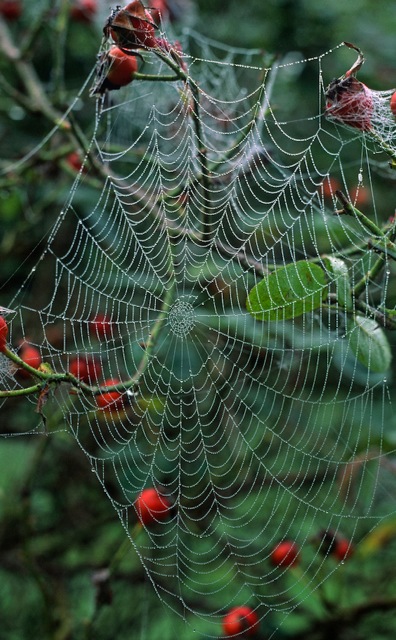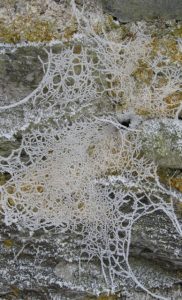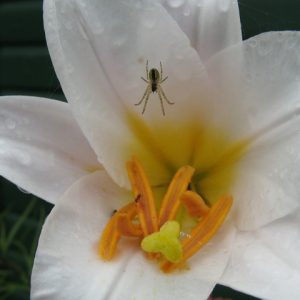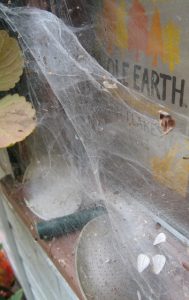The concept of ‘beneficial insects’ overlooks the fact that in the greenhouse, some of our most important allies are of the eight-legged persuasion.
They tend to startle rather than dazzle, and have us recoiling rather than rejoicing. They’re upstaged and outshone by their six-legged, airborne cousins, and they frequently make us jump out of our skin. If they venture indoors, we flatten them without a second thought, and they’re the wellspring of poppycock newspaper headlines. They do us two-legged giants no harm, and in our gardens, greenhouses, porches and polytunnels, they do immeasurable good. They walk on, spin with, skitter about on, and stalk and run their quarry down on eight legs. They rarely win nature’s beauty pageants, and as gardeners we are guilty of overlooking them; they fall outside the remit of that well-worn phrase ‘beneficial insects’ because they’re not insects, but arachnids. These undervalued, maligned, tireless and year-round gardening allies – especially in a greenhouse – are spiders.

I confess my heart still skips a beat when a big ‘house spider’ scuttles across the floor, as they’re doing right now on their amorous rambles (the bigger beasts are males of Tegenaria spp. in search of the smaller females, which they shack up with for several weeks – after which the male dies and is eaten by the female). But the more I learn about spiders, daunting and diminutive, dour and dazzling, the more I’m awed by them. We’re in that time now when early morning mist dancing atop heavy dew reveals just how interwoven their silken threads are in the living fabric of our gardens (if you’re short on dew, spraying a fine mist of water among your plants brings otherwise hidden cobwebs to life).
Here, spiders are everywhere. Under the dry, relatively predator-free eaves of the cottage, those species which spin classic, orb-shaped webs thrive. On cool, damp summer nights when midges form whining, bloodthirsty clouds, the cobwebs twang and judder as midge upon midge becomes arachnid fodder. These spiders’ only real nemesis appears to be long-tailed tits, which now and then hang precariously from the flaking paintwork, pecking either for strands of silken nest binding, or for a juicy titbit. The garden walls, if you look closely, are clothed in webs stretched out across the slate, each with a dark ‘tunnel’ near its centre, where a fast-moving killer waits its chance; a minuscule vibration across the web – which is how many spiders sense their catch – sees it dart, at lightning speed, out across the web to secure its ensnared prey.

Similarly swift movers are found at ground level. In summer, I dance hopscotch-like along the hot slate paths as athletic ‘wolf spiders’ scatter in all directions while I do my best to avoid treading on them. These free-ranging eight-legged allies don’t restrict themselves to a static cobweb, but roam and hunt for their prey which, like that of most spiders, is almost exclusively insects. These nomadic hunters carry their egg sacs on their backs, and some species carry their spiderlings around for a while after they’ve hatched. Mulching around your plants, especially crops prone to insect pests (think cabbage root fly), is a sure-fire way of rolling out an instant ecosystem that will attract wolf spiders, together with much else, including slug-hunting ground beetles. Dry, crispy mulches work best; I use the crumbling brown fronds of wild ferns gathered from the banks below the garden, but old straw or hay work too.
If spiders devoured slugs, we’d be singing their praises from our shedtops; ‘beneficial insects and arachnids’ would be the new mantra of all earth-friendly, organic gardeners. It turns out that some spiders probably do eat slugs – but only those species (Meta menardi and M. bourneti, orb-weavers that reach 3cm across) which live in total darkness, deep in caves, and in sewers, culverts, cemetery vaults and the central light-starved portions of long railway tunnels (where the menu is limited).

But while I might not be able to rely on arachnid allies for slug control, in my greenhouse, with airborne insects showing similar ‘pest potential’, it’s a different story. Here, every conceivable nook, cranny and hidey-hole has become spider-rich habitat, whether it’s in the eaves, in the joints where frame meets glass, or in the dark crevices around the greenhouse base. Under cover, and protected year-round from both predators and all climatic hazards bar temperature changes, spiders of all shapes and sizes weave their traps, from orb-shaped cobwebs big and small, to horizontal sheet-like webs that, if you peer into them, resemble a silken metropolis straight from a fairytale.
One such construction is underway on my kitchen windowsill (which is inside my lean-to greenhouse). Intricate and multi-layered, it started off as the craftwork of a single adult, which stood guard in a chamber at one end of its gossamer palace. In recent weeks, it’s also been home to infant spiderlings dashing over the silken sheets to grab whatever meal falls there. Like my other eight-legged allies, they get an extra treat come dark, when the kitchen light lures night-flying insects to the glass before they plummet to those soft yet fatal sheets of silk. There’s squeamish satisfaction watching a blood-sucking mosquito become spider food.

Fine, almost invisible strands of silk are hard at work too. Tiny, luck-bringing money spiders, just a few millimetres across, land here (via the greenhouse door and vents) on the wind-carried gossamer threads by which they travel. They spin small, sheet-like webs among the tomatoes, strawberries and other plants, waiting patiently below them for any loose-footed aphids to fall. It’s in high summer, when spiders, alongside aphid-munching hoverfly larvae and parasitoid wasps, whose grubs eat greenfly from the inside out, are at full pelt, that ‘beneficial insects and arachnids’ hits home.
So what can you do to encourage these greenhouse and garden allies which, in their larger sizes, will probably always make us jump? The simple answer is a lot less – by becoming a lot less fastidious and by ditching the gardening equivalent of obsessive compulsive disorder. Some of the worst advice I’ve heard in recent weeks (on the radio) is that ‘it’s time to clean your greenhouse by washing down the glass and scrubbing out every nook and cranny.’ The glass (or plastic/polythene) must be kept clean – here’s to that – but there’s no need to evict your unsung allies, either by brush or macho pressure washer. So don’t fall prey to the cleanliness mania that now blights our lives, and let your spiders do their thing.
Let them dazzle you, and when you next see them entrap an aphid, rejoice.
Text and images © John Walker
Find John on Twitter @earthFgardener


